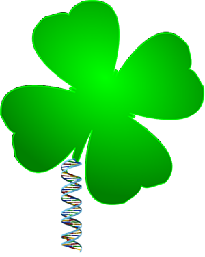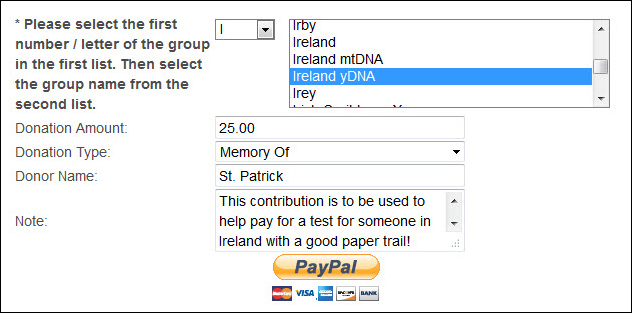Paying up, paying it forward
So here we are, once again, staring St. Patrick’s Day in the face.
 The day on which we see parades and pride and green beer.
The day on which we see parades and pride and green beer.
The day on which the flag being waved isn’t red, white and blue, but green, white and orange.
The day on which so many people wear green.
The day on which everybody, but everybody, either is Irish or wants to be Irish or simply assumes an Irish identity, at least for the day.
The day on which many genealogists check their DNA results and — if they can — point proudly to some often-infinitesmally-small percentage that some company says is likely from Ireland.1
And the day on which genetic genealogists often point to what’s actually been found about Irish DNA:
• As a group, looking at the autosomal DNA that people inherit equally from both sides of their ancestry — maternal and paternal, the Irish are more closely related to the Basque peoples of the northern Iberian peninsula than any other population.2
• On the maternal side — looking at the mitochondrial DNA people inherit from their mother’s mother’s mother and so on back through the generations — the Irish show “great genetic diversity, including lineages that dated back to some of the island’s earliest settlers (haplogroups U4, U5, U8), and some others that arrived more recently (haplogroups I, T1).”3
• On the paternal side — looking at the YDNA that men, and men only, inherit from their father’s father’s father and so on back through the generations — the Irish are “less diverse (88% of participants were haplogroup R1b), likely a result of the dominance of a few male leaders like King Niall of the Nine hostages…”4
Ah yes. Niall of the Nine Hostages.
That bit comes from the study in 2006, where researchers from Trinity College in Dublin announced that a high percentage of Irish men, including roughly one in five in northwestern Ireland, all had the same basic set of YDNA markers. The study they’d conducted showed “a significant association with surnamed purported to have descended from the import important and enduring dynasty of early medieval Ireland, the Uí Níill.”5
The study found that roughly 8% of Irish men had that YDNA chromosome, 21% in northwestern Ireland — and as many as one in 50 of American men who are descended from Irish immigrants with names like O’Connor, Flynn, Egan, Hynes, O’Reilly and Quinn.6
So… what if you’re not one of those one in 50… not an O’Connor or a Flynn … but you still need to prove that your male line actually does go back to Ireland?
The problem in using DNA, and here we’re talking the YDNA that only men have, in proving Irish descent is that you really really really want to match a man with a lot of YDNA markers — say, 65 of 67 or 108 of 111 or even — wouldn’t it be nice? — in some of the totally unique-to-your-family markers being uncovered in Family Tree DNA’s Big Y DNA testing.7
And you really really really want that guy that you match so tightly to be a man who has what you likely don’t have — a paper trail way back into Irish history.
And … sigh … there aren’t a whole lot of men living in the United States who have that kind of paper trail.
There are — no surprise here — a whole lot more men living in Ireland who have that kind of paper trail.
But they’re less likely to DNA test, and particularly less likely to DNA test with the company you tested with. (And, yes, for YDNA, I still recommend Family Tree DNA, and only Family Tree DNA. Nobody else really compares for YDNA testing.)
So what can you do to help change that?
Pay up. Pay it forward.
Seriously.
You can contribute towards the cost of a YDNA kit to be used for a test of someone living in Ireland with your surname.
You see, even the Irish are beginning to push YDNA testing, and an organization called the Clans of Ireland (Finte na hÉireann in Irish) — located in Dublin — is doing that very nicely. It explains on its website that:
Many Irish clans now have yDNA surname projects. These are based on the inheritance of the yDNA chromosome down through the paternal line. This kind of project is ideally suited to families bearing Irish patronymic surnames as the yDNA results generally reflect the surname.
The goals of Irish yDNA surname projects usually include the primary one of finding of relatives in Ireland. The goals sometimes include the desire to verify paternal ancestry and the identification of place of origin of the family. A history of the clan and its various branches can also be part of the goals of Irish Surname projects.
It has been the case for years that “Irish” yDNA Surname Projects have attracted people from many countries but they held little interest for the Irish who were still resident in Ireland. The argument has been that Irish who live in Ireland “know where they come from” and don’t need to do DNA tests.
However, Irish yDNA Surname Projects really need Irish-based participants to get involved in yDNA testing, for several reasons:
Irish-based families may wish to connect with relatives, who may have emigrated in times past, where there is no paper trail or living memory to help with making these connections. How many people in Ireland can say “most of my family emigrated in the Famine and we have no idea where they went or who their descendants are”. Or “we have no contact with branches of our family who left Ireland a long time ago”. Must this be the case? DNA can open doors for the Irish who have lost track of relatives.
Also, if more Irish men were involved in yDNA Surname Projects it would help the Irish diaspora who need yDNA results of Irish-based participants, to serve as “benchmarks” in their genealogical research. It is an exciting way to bridge the gap between the sometimes sad lonely emigration of the past and the modern world of global communications.8
It then lists 39 clans with YDNA Surname Projects — plus the overarching Ireland Heritage yDNA Project — for a total of 40 projects that you can join with your own test results.
But how can you help convince the Irish still in Ireland to test?
That’s where the “pay up, pay it forward” part comes in. Because, in my experience, the easiest way to convince folks to hand over a DNA sample when they’re not particularly interested in DNA testing themselves is to make it as painless to them as possible. And that means paying — or helping to pay — for the test.
Now I’ll be the first to admit that contributing to a project’s general DNA fund is a little bit like buying a pig in a poke. You personally won’t get to say specifically who the test kit will go to (unless you’re paying the entire cost for a particular person),9 and you may contribute weeks, months, even years before somebody in Ireland who meets the project’s wish list ever is found who’s willing to test. And the Group Administrator has discretion in picking the person to test if more that one candidate appears.
But if a project you’re particularly interested in can say, on its website, “We will pay 100% (or 50% or whatever) of the cost of a 67-marker YDNA test for a man who ___,” it’s a whole lot more likely that a man who can fill in that blank will decide to go ahead and test.
So if you want to toss in a few dollars — any amount is accepted — towards making a DNA test available to someone in Ireland who just might be the one you need to take your lineage back to the “auld sod,” here’s how you can do it:
1. Head over to the Family Tree DNA group general fund contribution page.
2. Find the project you want to contribute to by, first, using the small dropdown box to the left to get to the initial number or letter of the group (say, I for Ireland) and then the bigger dropdown box to the right to find the specific project (say, Ireland yDNA).
3. Fill out the donation amount.
4. Decide the donation type (in memory of, in honor of, anonymous, etc.)
5. Add your note about what you want the money used for.
You can see from this graphic how you might fill out this form:

Finally, you need to decide whether to contribute online (using PayPal or a credit card) or by mail. If by mail, you can print out the form and sent it and your check to the address at the bottom. If online, click on one of the buttons (PayPal or a credit card) and follow the prompts through.
And there you have it. A somewhat different way to help celebrate St. Patrick’s Day.
And oh… by the way … if your heritage, like mine, is Scots-Irish, and you’ll likely be wearing orange tomorrow, you’re not out of luck. For us, there’s the Ulster Heritage DNA project… and it takes contributions too…
SOURCES
- That includes me, by the way. AncestryDNA is the only company to specifically break out Ireland from the British Isles and it pegs my Irish ancestry at a whopping 1%. Éirinn go Brách! ↩
- Damian Corless, “DNA blueprint of the Irish revealed,” Independent.ie, posted 4 Dec 2012 (http://www.independent.ie : accessed 15 Mar 2014). ↩
- Miguel Vilar, “The Genographic Project Returns to Ireland to Reveal DNA Results,” National Geographic Newswatch, posted 21 Nov 2013 (http://newswatch.nationalgeographic.com : accessed 15 March 2014. ↩
- Ibid. ↩
- Laoise T. Moore, et al., “A Y-Chromosome Signature of Hegemony in Gaelic Ireland,” American Journal of Human Genetics 78 (Feb 2006): 334-338. ↩
- See also Nicholas Wade, “If Irish Claim Nobility, Science May Approve,” New York Times, online edition, published 18 Jan 2006 (http://www.nytimes.com/ : accessed 15 Mar 2014). ↩
- For more information about the Big Y test, see Roberta Estes, “Big Y Release,” DNA-eXplained blog, posted 27 Feb 2014 (http://dna-explained.com/ : accessed 15 Mar 2014). ↩
- “Clan DNA Projects,” Clans of Ireland (http://www.clansofireland.ie : accessed 15 Mar 2014). ↩
- If who gets tested is really critical in whether you’re willing to contribute, you can always contact a project group administrator and tell that person you’ll be willing to pay all of the costs of a test, but only for a person who matches specific criteria. And then wait and hope that kind of a person is found soon enough to take you up on the offer. ↩



Another reason to take a look at Irish DNA is for a health condition called Hereditary Hemechromatosis. Our 24 year old son was recently diagnosed with it. Here is some info: http://celticcurse.org/
Just looking to expand knowledge!
Happy St Pats & all that..
Absolutely worth looking at all hereditary illnesses, Denise — and hemochromatosis isn’t just among the Irish!
The Irish are not related closely to Basque on autosomal dna. The closest population to the Irish using autosomal dna is other British populations. Even using y R1b the Irish aren’t particularly close to the Basque. It’s like saying the closest population to the Dutch is Basque. It doesn’t make much sense.
http://scienceblogs.com/notrocketscience/2008/09/01/european-genes-mirror-european-geography/
Tell that to the folks who did the Irish study. They seem to think so!
I think the Irish study was based on research that was done about 10-15 years ago. The closest relatives of the native Irish – not the so-called “Scots-Irish” who are just British colonists – are the Welsh and the western Scots.
Check out this website for links to more recent genetic research involving the Irish:
http://www.khazaria.com/genetics/irish.html